Cromer-Artcraft Pen Company 1920 to c. 1933
by Jim Mamoulides, June 4, 2023
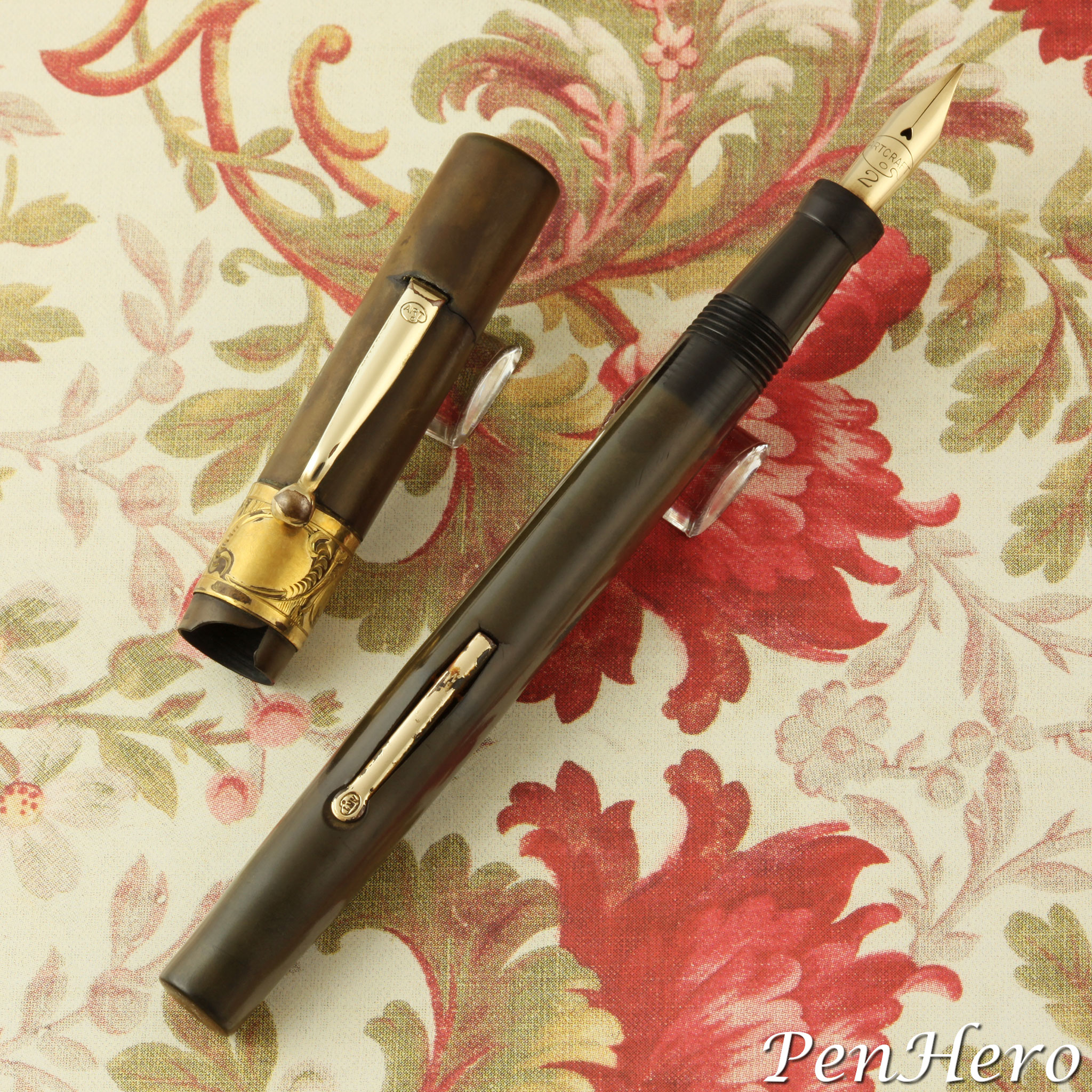 Artcraft Black Hard Rubber Fountain Pen c. 1922-1925
Artcraft Black Hard Rubber Fountain Pen c. 1922-1925
A Mystery Pen From Birmingham, Alabama
When I picked up this black hard rubber Artcraft fountain pen my first question was, “Who was Artcraft?” I had never previously heard about the company nor seen any of their pens. This discolored and cracked cap 5 5/16 inch long black hard rubber lever fill pen has a very interesting barrel stamping: Cromer Pen Company Inc. over Artcraft Fountain Pens over Birmingham Alabama. Centered in the text is an artist’s palette with MAKERS OF over ARTCRAFT inside. The gold nib is stamped with an artist’s palette logo and ARTCRAFT stamped inside over 2. The front of the cap band has a framed cartouche for personalization that carries around to the back with a flower and leaves design. The breather hole on the back of the cap is much larger than on other brands.
Time For Some Sleuthing!
Artcraft began in 1920 as the Edison-Cromer Pen Company, incorporated with $20,000 in stock and with Ford Dalton Cromer as president, pharmacist George Brooks Forbes, his wife’s father, as vice president, and Harriet (Glanville) Forbes Cromer, his wife and Forbes’ daughter, as secretary. Ford Dalton Cromer was born on August 10, 1886, in Christiansburg, Virginia, a small town in western Virginia near Blacksburg. His parents were Frank W. Cromer and Demie Thompson Cromer. By 1903, when he was about eighteen years old, he had moved east across Virginia to Norfolk, working in various clerk jobs, including at the Howard Drug Company, until he became a traveling salesman by 1909.
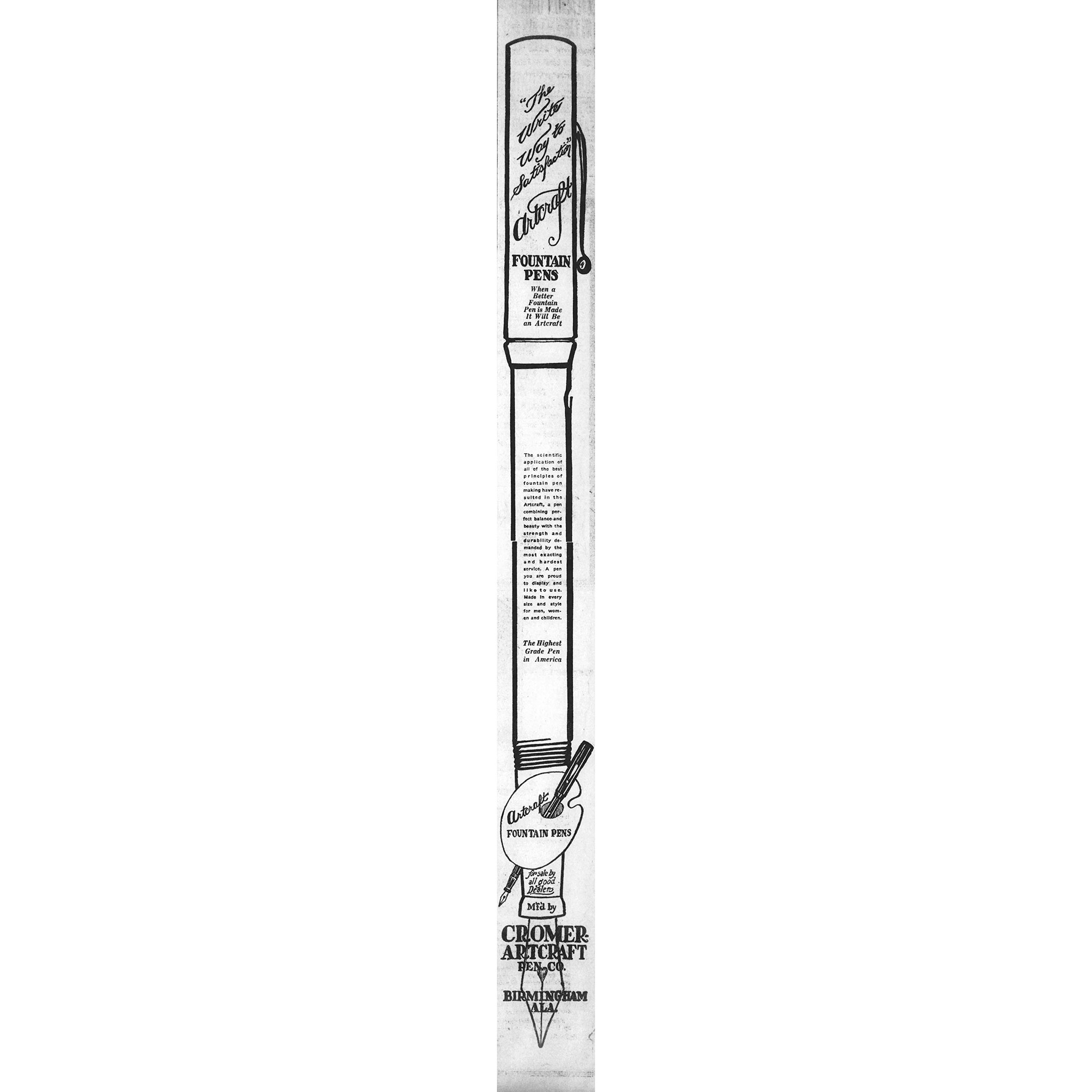 Earliest known Artcraft advertisement from The Birmingham News, February 24, 1921
Earliest known Artcraft advertisement from The Birmingham News, February 24, 1921
Cromer’s story, as told in a 1922 interview, is that he began his experience “making pens” about twelve years earlier in Wisconsin, which likely means he spent some time at Parker, though he did not name that company. This had to be sometime between 1909 and 1913, because by 1913 Cromer had moved to Petersburg, Virginia. On February 3, 1913, the Edison Pen Company, Inc., was formed with $15,000 in capital with Ford Cromer as president, George S. Bernard, Jr. as vice president, and S.W. Holden as secretary-treasurer. Cromer continued as president in Petersburgh, as documented in the Petersburgh City Directory, through 1918. Interestingly, his June 5, 1917, draft registration card lists him as a traveling salesman for the Edison Pen Company and living at the Ponce De Leon Apartments in Atlanta, Georgia. He claimed eyesight as a draft exemption and later photos show him wearing glasses. Was Cromer both president and a traveling salesmen for Edison living in Atlanta? We’ll see more on this later on in this article. Another interesting nugget is that Remmie Arnold, born January 25, 1894, in Petersburg and later president of the Arnold Pen Company of Petersburg, Virginia, was listed in the Petersburgh City Directory from 1915-1918 as a clerk for the Edison Pen Company.
How Did Ford Cromer Wind Up In Birmingham?
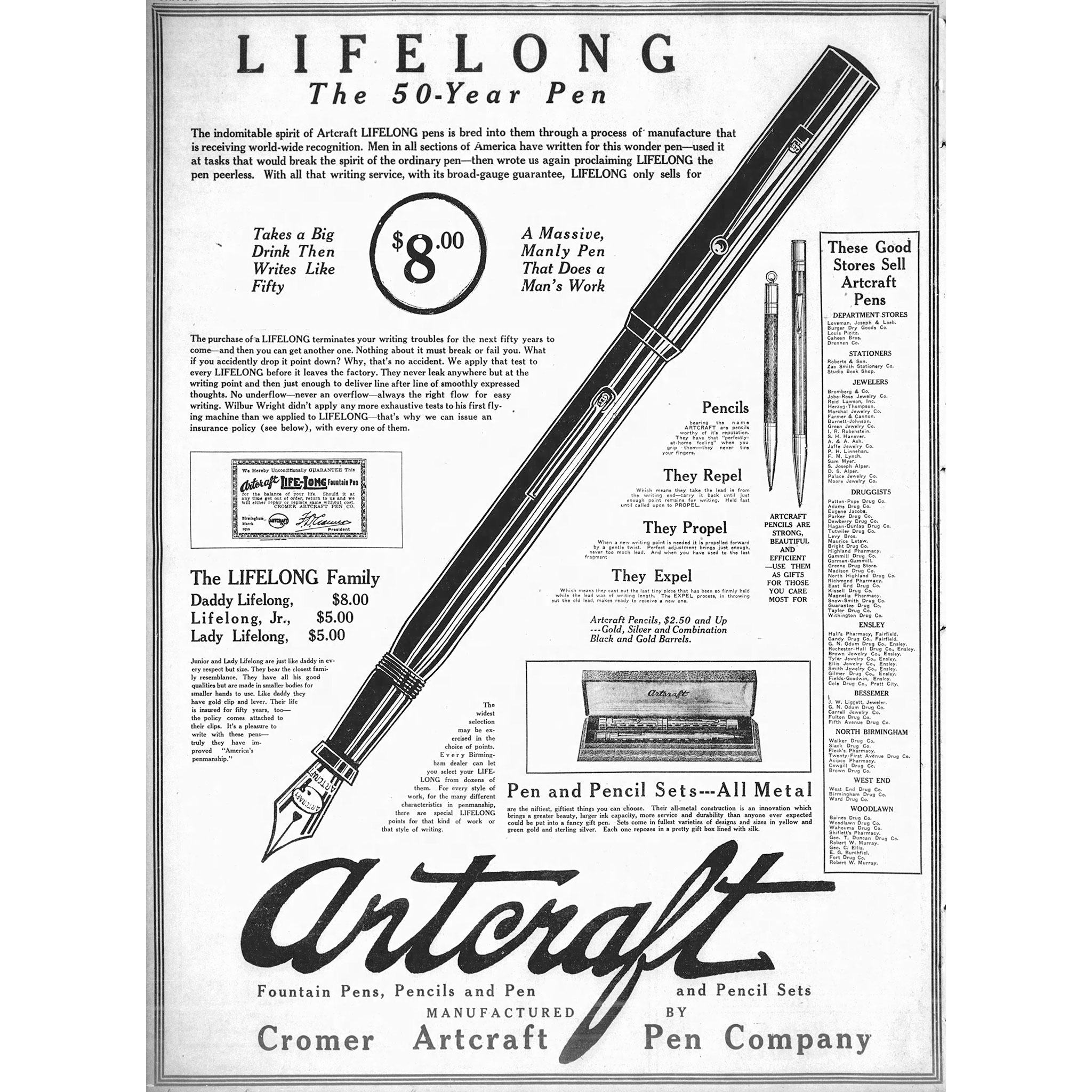 Earliest known Artcraft Life-Long advertisement from The Birmingham News, November 19, 1922
Earliest known Artcraft Life-Long advertisement from The Birmingham News, November 19, 1922
It’s not clear when Cromer met Harriet Glanville Forbes, born in October of 1899 and daughter of Brooks and Hattie Forbes, nor how long the courtship and engagement lasted, but she was the catalyst to move him from Atlanta, Georgia, where he was living as of May 1919. It’s possible he had Edison Pen Company business in Birmingham, Alabama and traveled back and forth between there and Atlanta. Their wedding was announced in the society pages of the Birmingham News on October 5, 1919, with photos not only of the bride, described as a “most attractive young woman of a rare blond beauty, who dresses with much style and distinction,” but also the six bridesmaids, arranged around her photo. The wedding was held Wednesday, October 22, 1919. Cromer’s wife was a regular subject in the Birmingham News society pages.
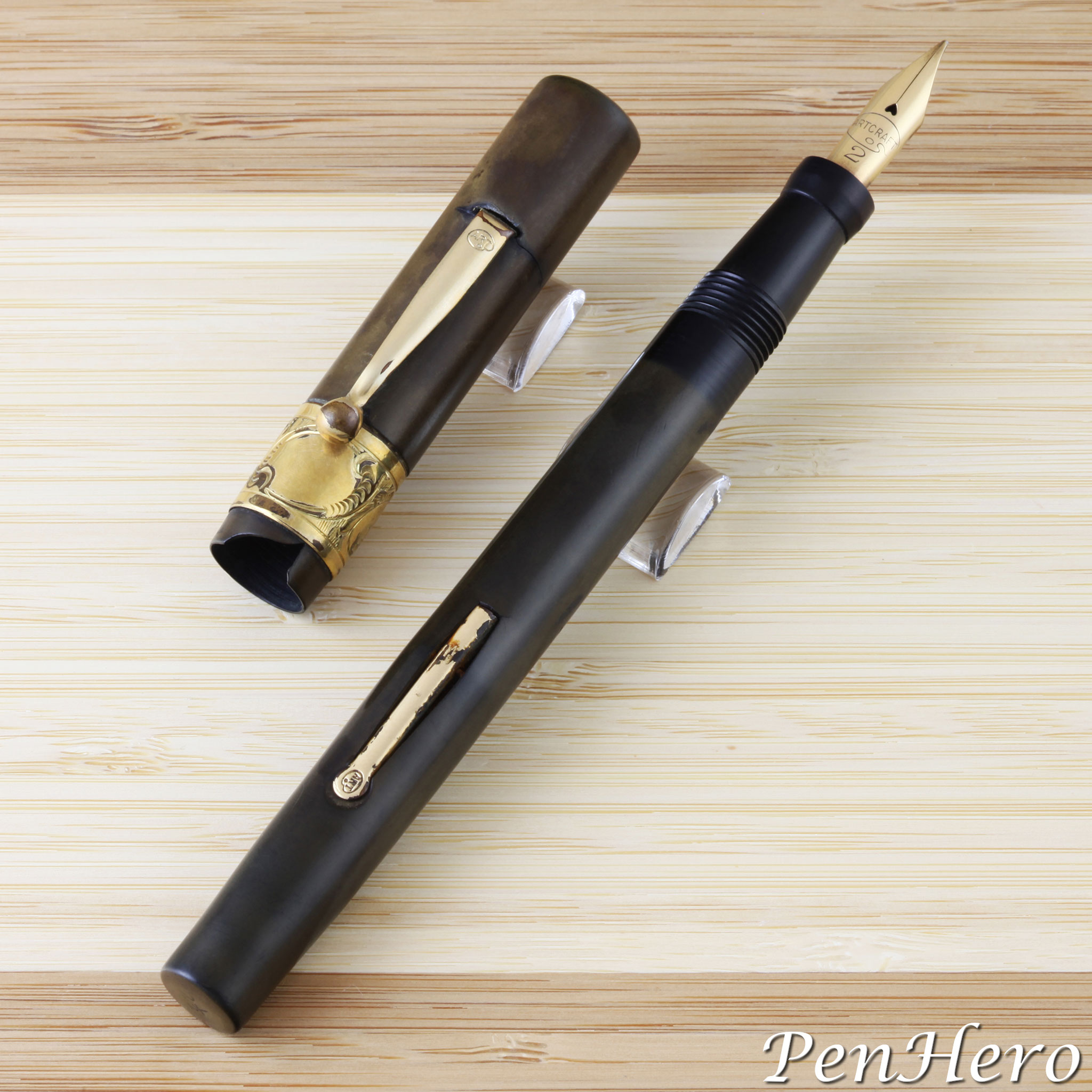 Artcraft Black Hard Rubber Fountain Pen c. 1922-1925
Artcraft Black Hard Rubber Fountain Pen c. 1922-1925
From Edison to Artcraft
The 1920 Petersburg, Virginia, City Directory still listed Ford Cromer as president of the Edison Pen Company but now noted he lived in Birmingham Alabama. Cromer’s listed occupation in the 1920 U. S. Census was manager of a pen store in Birmingham, Alabama. Things were about to change. Since Cromer was experienced in the pen making business and now married to a local girl, it’s no surprise that he proceeded to set up a new pen company in his new hometown. In a February 26,1922 interview Cromer says he began the new Birmingham venture in March 1920, only six months after his wedding, which is a good indication that this was his plan all along. On April 9, 1920, the Edison-Cromer Pen Company was incorporated with $20,000 in stock. Ford Cromer was president, Brooks Forbes was vice president, and Harriet Cromer was secretary.
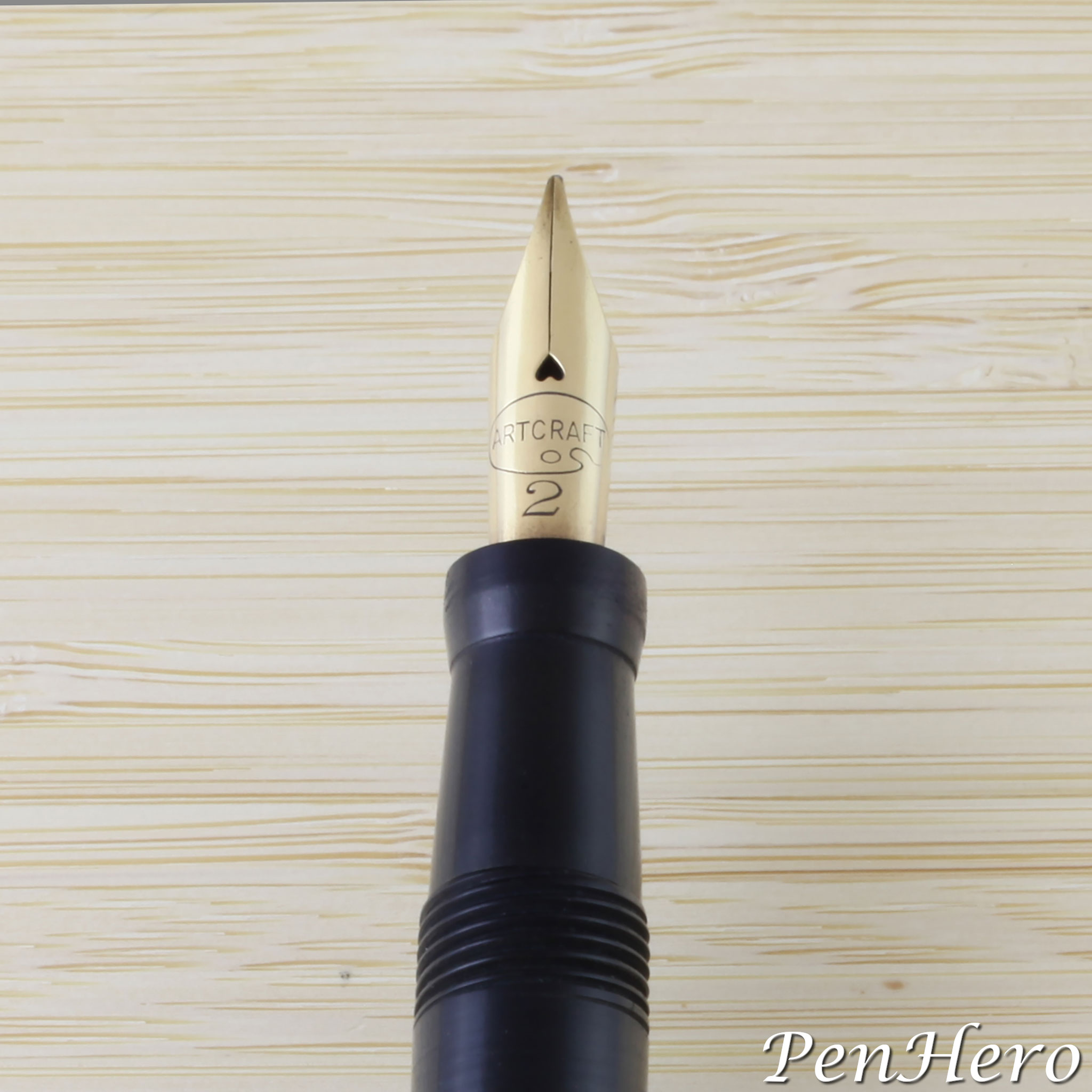 Artcraft Nib Showing Artist's Palette Logo c. 1922-1925
Artcraft Nib Showing Artist's Palette Logo c. 1922-1925
By February 24, 1921, the company was trading and advertising as “The Cromer-Artcraft Pen Company,” though pen retailers would shorthand it in their ads to simply Artcraft. Why Artcraft? Unfortunately, I haven’t found anything that describes how the name came into being nor any evidence from a trademark search, but Cromer is recorded as saying he copyrighted the trade name “The Artcraft Pen.” The name Artcraft was already in use locally by a roofing company and nationally by the Paramount movie studio as “Paramount-Artcraft Motion Pictures.” At this point I can’t say how the name was chosen. Maybe Cromer just liked it? Why drop Edison? We’ll find out about that further down.
Cromer worked to establish himself and his business presence in the local community, joining the Birmingham Civitan Club as of July 30, 1920. Civitan, by the way, was founded in Birmingham in 1917 as the result of local Rotary Club members wanting to put more focus on community service rather than business connections. The name Civitan is derived from the Latin word for Citizenship. In April 1922 Artcraft also became a member of the Birmingham Business Equipment Association.
Cromer wanted to expand the company outside the local area as with other regional office equipment and stationary businesses by joining and sending J. E. Shelton to represent Artcraft at the Second Annual Meeting of the Southeastern Division of the National Association of Stationers and Manufacturers on April 21, 1922, in Atlanta, Georgia.
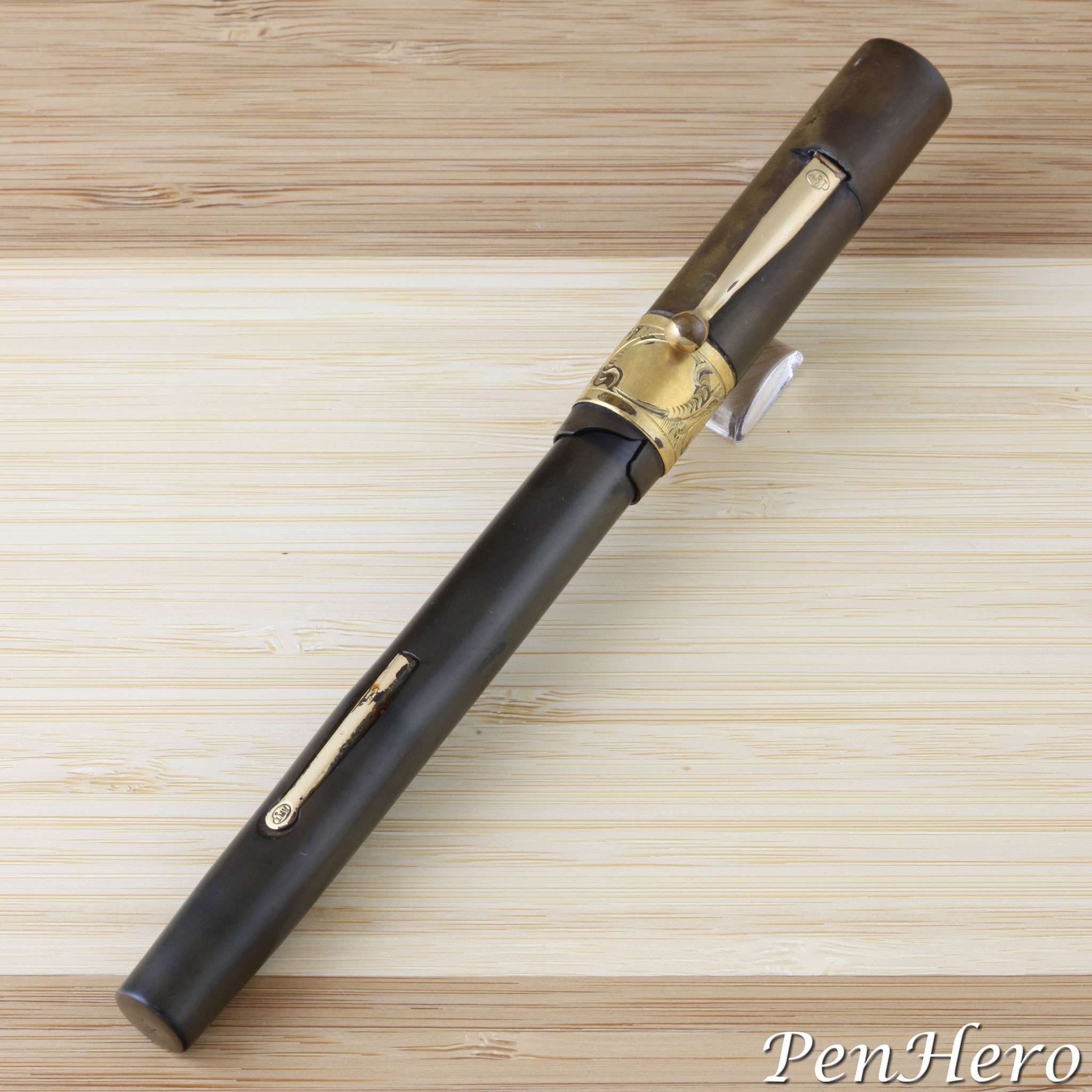 Artcraft Black Hard Rubber Fountain Pen c. 1922-1925
Artcraft Black Hard Rubber Fountain Pen c. 1922-1925
Cromer also had his eye on expanding his business overseas, with his first known trip taken to Havana, Cuba announced December 27, 1922. This was to set up distribution in “Cuba, Central and South America” and would lead to many, if not annual, southern trips by Cromer, frequently to Rio De Janeiro and Buenos Aires and continuing through the late 1940s.
Did Artcraft Make Their Pens Or Job Them Out?
There are a number of rumors about who actually made Artcraft pens. Fortunately, there are two sources that appear in the Birmingham News that I think settle that question. First is the Birmingham News front page article titled, “Birmingham Girl Brings Big Fountain Pen Industry Here With Just One Little Word” on February 26, 1922. In the article, Ford Cromer says he started in the fountain pen making business twelve years earlier beginning in Wisconsin, very likely with Parker, but it’s left unsaid, and then Virginia, with the Edison Pen Company. He sold his interest in Edison on his move to Birmingham to start another pen company there. His small Artcraft factory grew 60 percent from 1920-1921. By 1922 the company invested in automated machines that gave an output of more than 1,000 lever fill fountain pens a day. Artcraft had 150 designs that year ranging in price from $2.75 for basic models to $150 for solid gold pens. Large contract orders for pens were being taken from the Army and Navy. The newest addition to the 1922 line would be a propel, repel, expel pencil designed to hold a year’s supply of leads and an eraser under the cap top.
In the interview Cromer was asked “Are you making pens here or just assembling them?” His answer,
“Making them; making them as fully as any fountain pen factory in the country can make them. We do not make gold pen points, they come from abroad. The process of fusing the native iridium points – as hard as diamond – is a very delicate process indeed and requires a high degree of technical skill, besides expensive equipment, so we buy the very best points we can get; more expensive points than many other makers of pens use, simply because we determined to give the highest possible quality in our product. Have to, under outstanding offer of satisfaction or your money back.”
Cromer described in detail the manufacturing process from bringing in raw materials, lathe turning, chasing, metal work, and mounting trim parts. Artcraft sourced rough hard rubber tubing from Akron, Ohio. I’m guessing that was from Goodyear. Artcraft offered 14 karat gold iridium tipped nibs and a money back guarantee if not pleased with performance. A complete repair department was also set up with to service the pens they sold. As of February 1922, Cromer expected to employ twenty “artisans” in manufacturing and to grow quickly to as many as sixty.
In September 1922 Artcraft introduced the “Life-long” or “Lifelong” line with a fifty year guarantee. Both spellings were initially used, but eventually Life-Long in logo form became the choice. The earliest Life-Long advertisement calls them “The Methuselah of Fountain Pens” offered in three sizes: senior Life-Long for $8.00, Life-Long Jr. and Lady Life-Long for $5.00 each. Later advertisements claim the nib has, “Twice the usual amount of Gold and Iridium.” Soon after an all red “Redskin” senior model was offered for $7 as well as chased ebony hard rubber with a “lacquer red tip” for $8.00. Matching Junior and Lady Life-Long pens were $5.00 each. To make their pens stand out, Artcraft also invested in an innovative electric point of sale displays made by the Photo Plating Company of Minneapolis.
All that activity must have generated a lot of interest. There is a December 14, 1923, Loveman, Joseph & Loeb department store ad offering 1,000 Artcraft green gold filled chased ringtop sets for $8.50 for a $12 value.
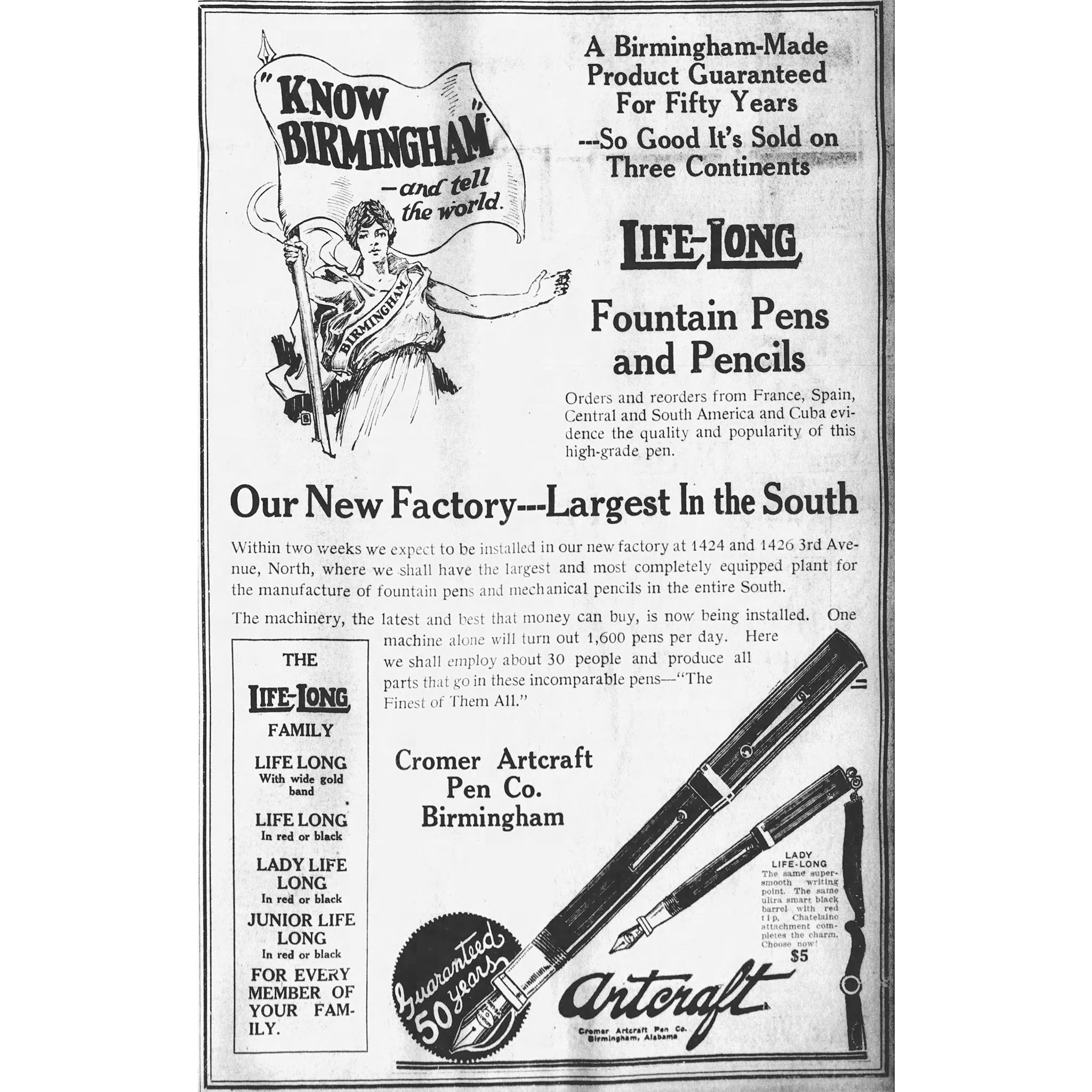 Advertisement in The Birmingham News, March 22, 1925
Advertisement in The Birmingham News, March 22, 1925
The second source is an article and a large advertisement both in the Birmingham News on March 22, 1925. Artcraft announced a new factory with the capacity of making 1,600 pens and pencils a day was expected to open in April 1925 at 1424-26 Third Avenue North. This would include an investment of $12,000 in new automated machinery and employing at least thirty workers. The announcement claimed the new factory would be the largest of its kind in the south. It also stated the intent to make all their own parts in house.
As of 1928, Cromer-Artcraft company officers were Ford Cromer as president-treasurer, William Clifford Forbes, Harriet Cromer’s older brother by three years, as vice president, and Harriet Cromer as secretary, with offices at 1424 Third Avenue North. In spite of what looked like solid growth in the 1920s, Artcraft ran into a patent trouble. Sheaffer sued Artcraft in the case “W. A. Sheaffer Pen Co. v. Cromer Artcraft Pen Co., Inc.” to protect their 1913 lever-fill patent 1,111,240 titled “Attachment for fountain pens.” Sheaffer was awarded an injunction against Artcraft on June 2, 1928, to cease infringing the patent. I could not find any information on any other terms or payout as a result of the ruling. Even so, Artcraft continued to advertise, sell and was active in Birmingham through 1932. After that activity by Artcraft in Birmingham appears to grow quiet.
150 Different Designs? A Survey
Since I don’t have any catalogs or other company information available, I did a deep dive on available Artcraft advertisements to see if I could get a sense of how broad their line really was. I did not expect to identify anything close to the 150 designs Cromer claimed they were making, as pen companies very rarely put their complete catalog in advertisements. Does 150 designs actually sound like a lot? Artcraft, like other pen companies, assigned a style number (like a model number) to their pens and pencils. This can be seen in several advertisements. This is how dealers select and order what they want to sell. Let’s say in 1922 Artcraft made sterling silver and gold filled pens with the same engraving designs and a matching pencil for each. To keep it simple, let’s also say that they made black hard rubber pens and pencils. If they made a ringtop, junior and senior size of each of these that would be 18 different products. If Artcraft only used 8 engraving designs on each, that would result in 144 styles. The claim seems easily plausible, but I can’t verify it as I don’t have production or sales records.
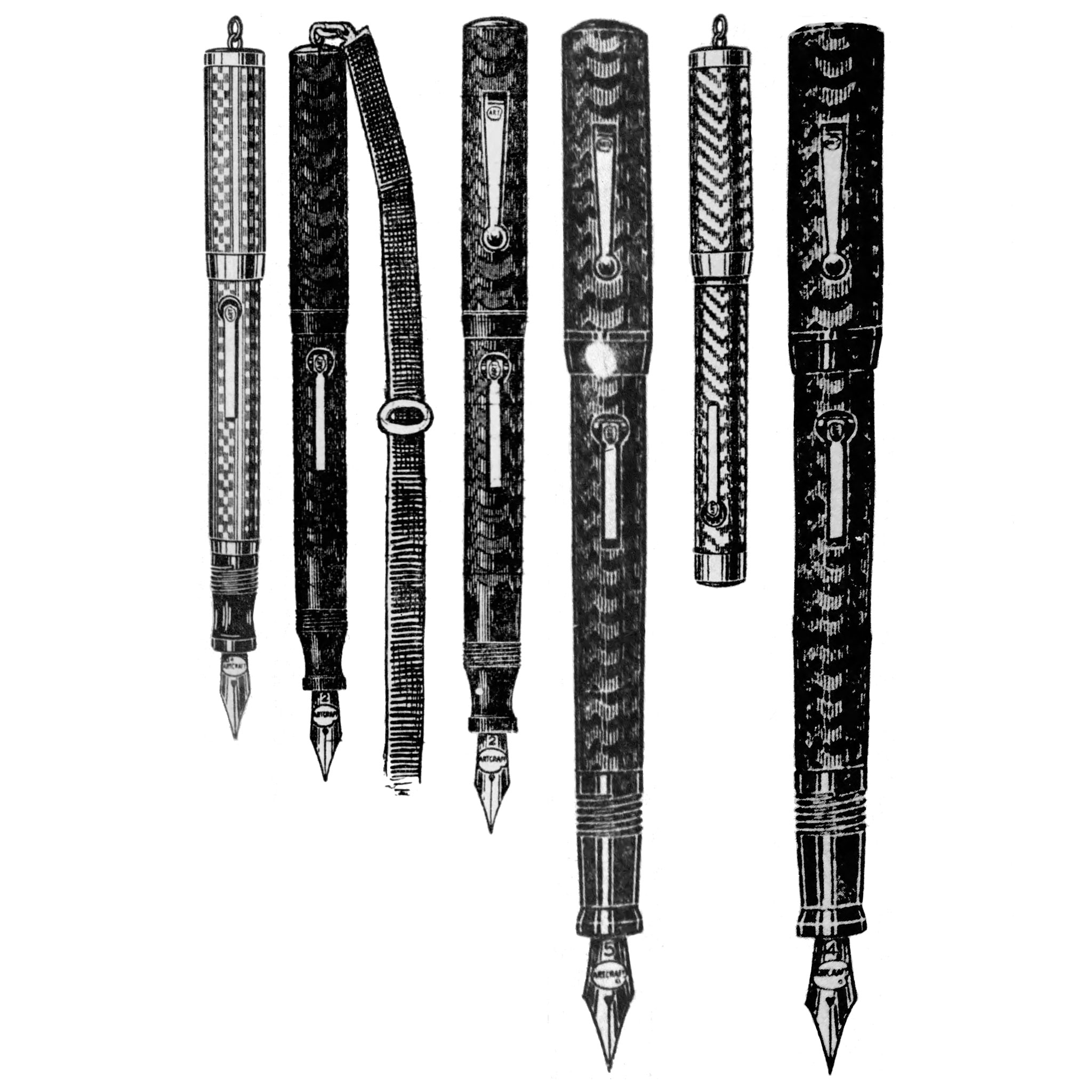 Artcraft Model Illustrations From 1921 Advertisements, Size Comparisons Are Approximate
Artcraft Model Illustrations From 1921 Advertisements, Size Comparisons Are Approximate
In 1921 Artcraft ads give a hint of a broad line of metal and hard rubber ringtop pens, junior size pens and senior size pens. These earliest small engraved ringtop pens in a checkerboard and herringbone (model 10-G) engraved pattern are shown with a larger cap with a beveled edge. This style of beveled cap overlapping the barrel can also be seen on 1921 Wahl ringtop pens. All styles of black hard rubber pens, ringtop, junior, and senior, are shown with the same herringbone chasing, a popular style at that time. Three different nib sizes are shown, 2, 4 and 5. The chased hard rubber ringtop pen and the junior pen (both style 2 1/2A) all show a retail price of $2.75; the number 4 nib senior (style 4) was $4.25 and with a number 5 point (style 5) was $5.25. The model numbers on the chased hard rubber pens indicate a likely relationship to the point size. The herringbone metal ringtop was $8.00.
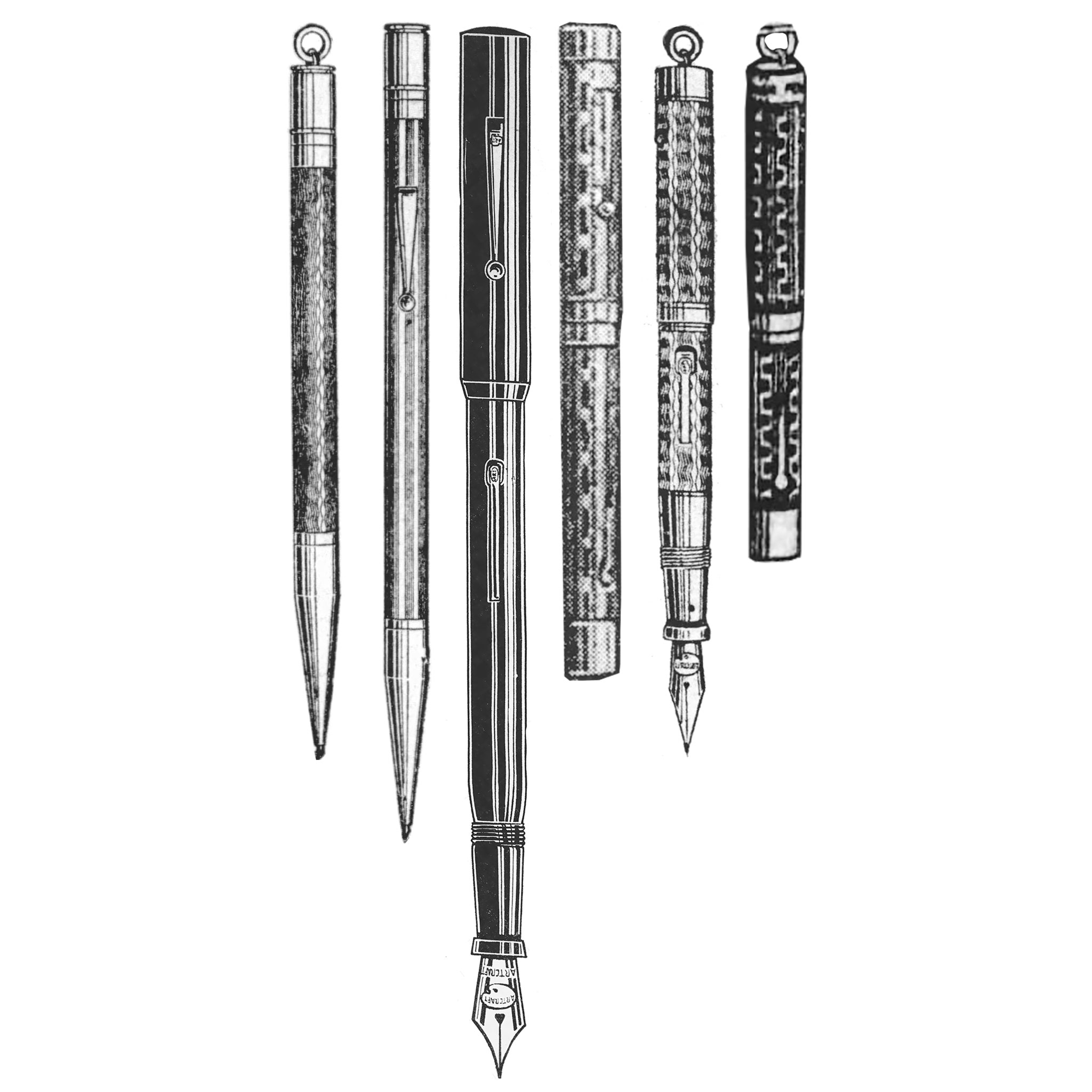 Artcraft Model Illustrations From 1922 Advertisements, Size Comparisons Are Approximate
Artcraft Model Illustrations From 1922 Advertisements, Size Comparisons Are Approximate
In 1922 Artcraft ads show new changes to the product line. In September 1922 Artcraft introduced the “Life-Long” or “Lifelong” line (both spellings are used) with a fifty year guarantee, calling the line “The Methuselah of Fountain Pens.” A full page advertisement in the Birmingham News on November 19, 1922, describes the new Lifelong 50 year guarantee pens in detail. These are hard rubber pens and the largest, an $8.00 senior size pen is named “Daddy Lifelong.” There is also a “Lifelong Jr.” and “Lady Lifelong,” a ringtop pen, each retailing for $5.00. Colors are not stated. This ad also describes in detail the new repel, propel, expel pencils, showing two engraved designs, ribbon and zigzag, in two sizes, ringtop and Junior. There also is what appears to be a junior size metal Greek Key engraved pen and pencil set. Gold, silver, and black and gold barrels are available. A December 13, 1922 advertisement in the Birmingham News shows a newer design on gold, gold filled and sterling silver engraved metal pens where the cap and barrel are the same diameter, fitting flush with the cap on. These new pens also carry a new branding, “Artcraft Allmetal.” Wahl also makes this design change to their metal pens in 1922, but it’s unknown if Artcraft is following their lead.
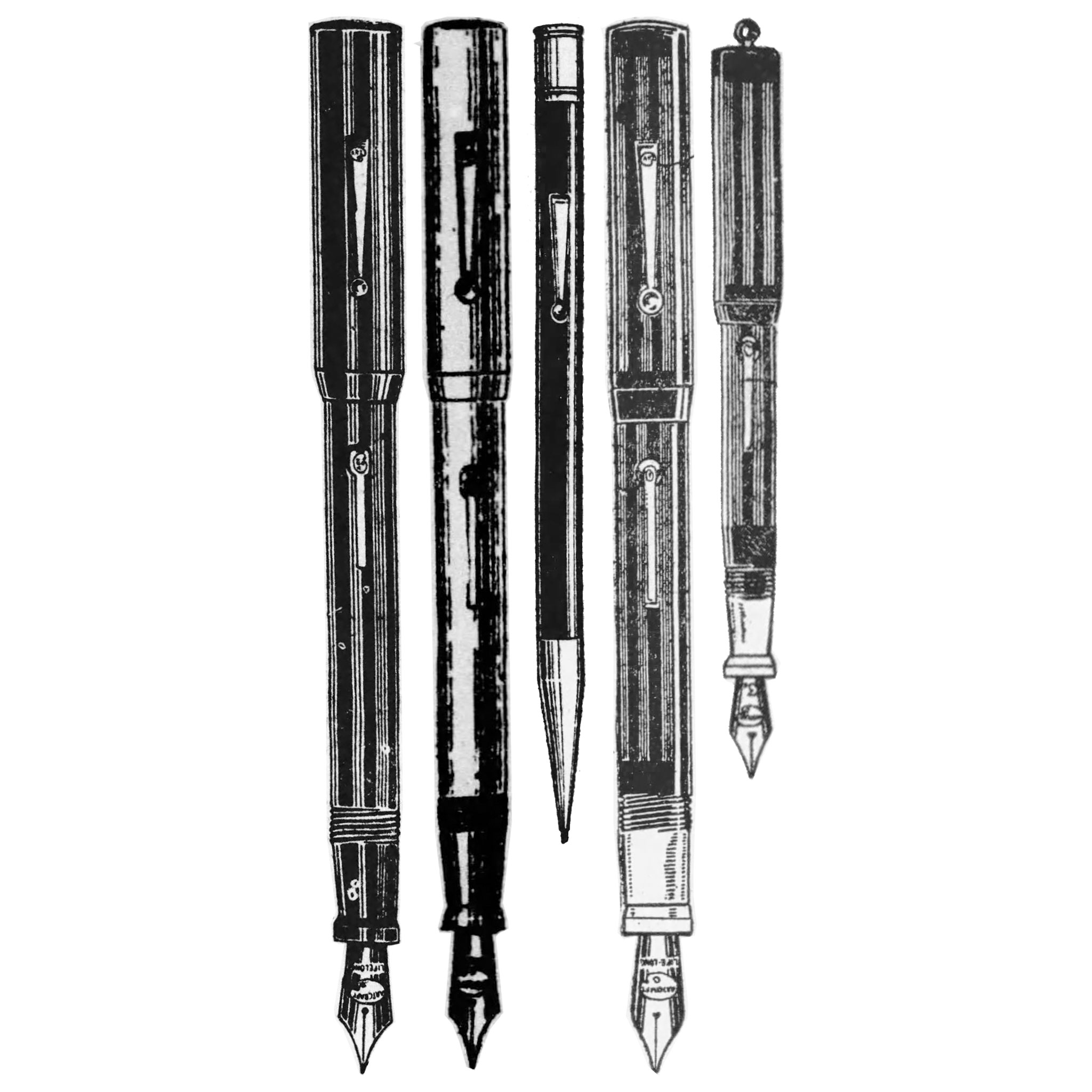 Artcraft Model Illustrations From 1923 Advertisements, Size Comparisons Are Approximate
Artcraft Model Illustrations From 1923 Advertisements, Size Comparisons Are Approximate
In September 1923 Artcraft expanded the “Life-Long” line, appearing to settle on that spelling. There is now a “Redskin,” the “Chief of the Campus,” with a lacquer red barrel with a black tip with the senior size now selling for $7.00, the junior and lady, shown with a number 3 nib, still at $5.00. Does that description and price point sound familiar? Life-Long also comes in a ribbon chased black hard rubber version at the same price points and lacquer red sections on those pens are first seen in a November 28, 1923 advertisement in The Andalusia Star newspaper. There is also the first image I found of a black hard rubber junior size pencil in the September 17, 1923 Birmingham News. In an ad in the November 25, 1924 Chattanooga News the price of the oversize Life-Long ribbon chased black hard rubber with lacquer red tip pen is first seen with a price increase to $8.00, with no change in price for the Junior or Lady models.
In the March 22, 1925 Birmingham News Artcraft ran an advertisement announcing their new factory, claiming it as the largest in the south with a capacity of producing 1,600 pens a day and that the company is selling on three continents, including the countries of France, Spain, and Cuba as well as South and Central America. The ad also shows a new Life-Long model with a single wide gold cap band. I reviewed many advertisements in 1925 and none indicated that this new model differed in price from those without the cap band.
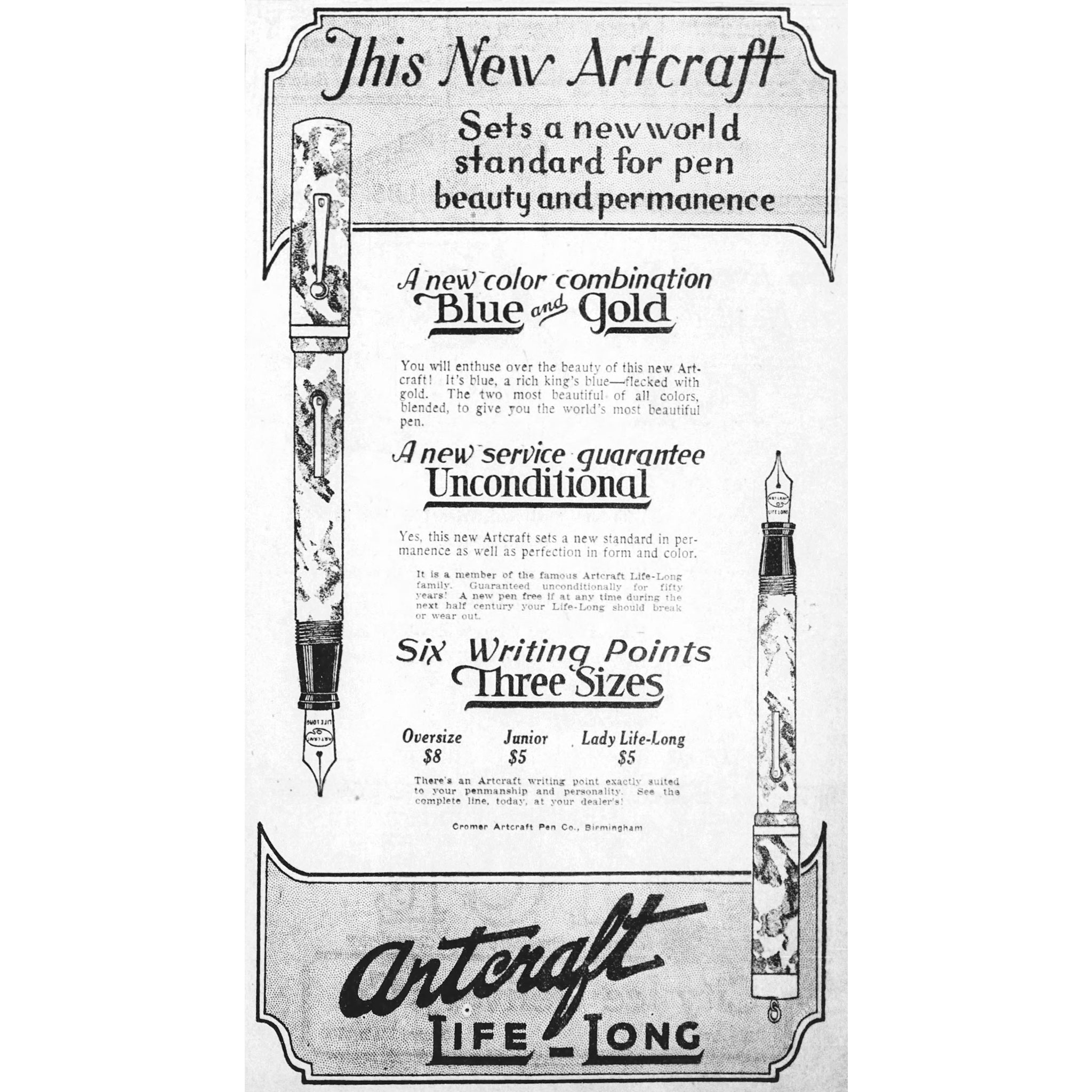 Advertisement in The Birmingham News, August 23, 1926
Advertisement in The Birmingham News, August 23, 1926
In the August 23, 1926, Birmingham News Artcraft ran an advertisement announcing the new Blue and Gold Life-Long pens featuring three writing points and priced at $8.00 for Oversize and $5.00 for either the Junior or Lady Life-Long. The color is described as a “rich king’s blue – flecked with gold. Undoubtedly this is a celluloid pen. I wondered if the celluloid is the same as that used on the Waterman Patrician, but in a discussion with Jon Veley, who has one of the pencils, he recalls it as distinctly different. I would really like to see one of these pens. In 1927, Artcraft was offering more colors of celluloid pens and pencils. By 1928, fifty different color combinations and designs were offered.
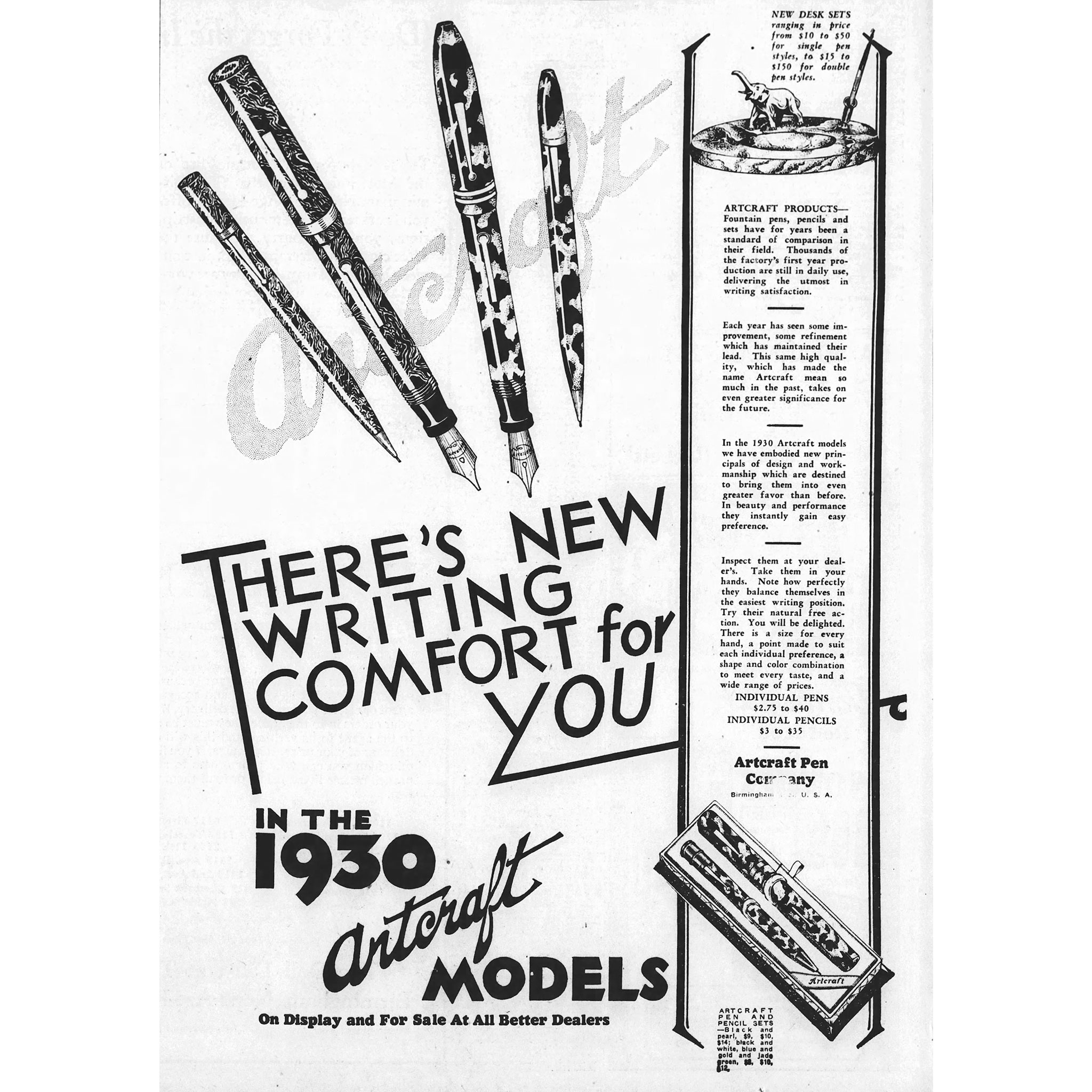 Advertisement in The Birmingham News, December 9, 1929
Advertisement in The Birmingham News, December 9, 1929
In the December 9, 1929 Birmingham News we see the first Artcraft balance shaped pen. The ad has a similar look and feel to Sheaffer ads by showing the new balance shape pen next to the previous model. Though there is no mention of the new pen’s model name, the ad copy says, “Note how perfectly they balance themselves in the perfect writing position.” There also is no more mention of the Life-Long branding. Four colors are offered: Black and Pearl, Black and White, Blue and Gold, and Jade Green. I found a 1930 ad that gives the balanced pen the name “Tapered” and priced at $10.00, with a $4.00 matching pencil.
Low priced Ford branded pens first appear in advertisements in 1930. After 1930 Artcraft company advertisements become scarce and the latest Artcraft full retail ad I could find was by the Jobe-Rose Jewelry Company in the September 25, 1932, Birmingham News showing much lower priced balance shaped pen models: the Duo pen and pencil set priced at $3.95 and up, and the New Yorker pen and pencil combo for $1.98. By 1933 it’s clear that the company was in some trouble. The Loveman, Joseph & Loeb department store ran a “Reorganization Sale” with Artcraft on September 19, 1933, clearing out older, higher priced Artcraft pens for either ninety-eight or seventy-five cents each, based on their original retail value. A week later the retailer ran a follow-up ad saying they sold 7,000 Artcraft pens and pencils that month. After that, retailer mentions of Artcraft and Ford pens trickle out at offers of $1.00 or less and shortly afterward cease.
What's the Rest of the Story?
There is more to the Ford Cromer and Artcraft story, including more on Ford branded pens, Cromer’s travels and life in South America, his two patents, and later Artcraft products made in South America. His travels show many trips Rio De Janeiro and Buenos Aires continuing through the late 1940s. A short article in the November 17,1943 Troy, New York Times Record says that Cromer and his wife are “of Birmingham, Alabama and Buenos Aires.” There’s a story there as well. Ford Cromer died July 26, 1967, at the age of 81 and was buried in Birmingham.
Based on this single example, Artcraft pens appear to be well made, typical of second tier brands from the 1920s. This particular pen had not been restored and as I found no information on this model, I’m not going to include an identification guide nor a performance review. These are very uncommon pens and there are collectors who focus on the brand, including the early Artcraft pens, the later Ford pens, and Artcraft pens from South America. I would certainly like to see and photograph more examples, especially the Life-Long and metal pens. We’ll see what turns up and I’ll update this article and revisit the other parts of the Artcraft story in a future article!
References
1920 United States Federal Census
Advertisement, The Birmingham News, February 24, 1921, page 2
Advertisement, The Birmingham News, April 6, 1921, page 16
Advertisement, The Birmingham News, September 21, 1921, page 14
Advertisement, The Birmingham News, December 8, 1921, page 4
Advertisement, The Columbus Ledger, December 13, 1921, page 2
Advertisement, The Birmingham News, September 26, 1922, page 2
Advertisement, The Birmingham News, November 19, 1922, page 16
Advertisement, The Birmingham News, December 13, 1922, page 16
Advertisement, The Birmingham News, September 17, 1923, page 9
Advertisement, The Birmingham News, September 24, 1923, page 2
Advertisement, The Andalusia Star, November 28, 1923, page 3
Advertisement, The Chattanooga News, November 24, 1924, page 9
Advertisement, The Birmingham News, March 22, 1925, page 9
Advertisement, The Birmingham News, August 23, 1926, page 11
Advertisement, The Birmingham News, December 12, 1927, page 6
Advertisement, The Birmingham News, December 17, 1928, page 18
Advertisement, The Birmingham News, December 9, 1929, page 9
Advertisement, The Birmingham News, February 14, 1930, page 6
Advertisement, The Birmingham News, December 17, 1930, page 21
Advertisement, The Birmingham News, September 25, 1932, page 7
Advertisement, The Birmingham News, September 19, 1933, page 18
Advertisement, The Birmingham News, September 24, 1933, page 14
Alabama Manufacturers – Alabama, Industrial Development Board, 1930, page 18
“Artcraft Pens To Have Factory Here In 30 Days” The Birmingham News, Mar 22, 1925, page 2
“Attractive Young Matron” The Birmingham News, March 12, 1922, page 7
Birmingham, Alabama, City Directory, 1928 page 359 and 1929 page 353
“Birmingham Girl Brings Big Fountain Pen Industry Here With Just One Little Word” by Garrard Harris, The Birmingham News, February 26, 1922, pages 1 and 2
“Firms Incorporated” The Birmingham News, April 9, 1920, page 17
“In Birmingham” Geyer’s Stationer, November 9, 1922, page 20
Industrial Birmingham: The Home of Manufacturers - Birmingham, Alabama Chamber of Commerce, 1929, page 5
Jefferson County, Alabama Marriage License, October 21, 1919
“Leaves For Havana” The Birmingham News, December 27, 1922, page 19
“List of Charters and Amendments of Charters” Report, Virginia Secretary of the Commonwealth, 1913, page 267
Manufacturers Record, Vol 63, 1913, February 6, 1913, page 74
Norfolk, Virginia, City Directory, 1903 page 149, 1904 page 123, 1905 page 125, 1906 page 150, 1907 page 168, 1908 page 161, and 1909 page 164
“Patent Suits” Official Gazette of the United States Patent Office By United States Patent Office, 1928, page 278
Petersburg, Virginia, City Directory, 1913 page 111, 1915 page 148, 1916 page 178, 1918 page 186, and 1920 page 218
“Report of Proceedings of the Second Annual Meeting of the Southeastern Division of the National Association of Stationers and Manufacturers” National Association News, May 1922, pages 13-16
Republica Dos Estados Unidos Do Brasil Immigration Card - October 9, 1939
Republica Dos Estados Unidos Do Brasil Immigration Card - December 4, 1947
Republica Dos Estados Unidos Do Brasil Immigration Card - May 17, 1949
“Society Personals” The Birmingham News, January 20, 1920, page 14
“The History of Civitan” Civitan International, 2023
United States World War I Draft Registration Card, June 5, 1917
U. S. Deptartment of Labor Immigration and Naturalization Service Passenger List March 2, 1941
U. S. Design Patent USD92704S
Interact
Comments on this article may be sent to the author, Jim Mamoulides


